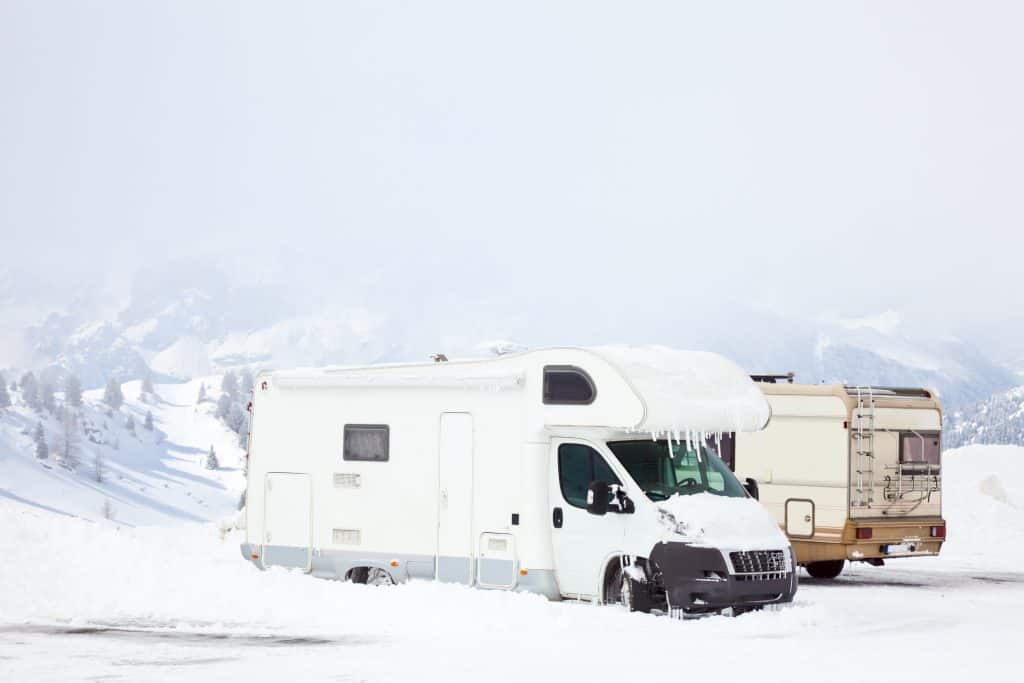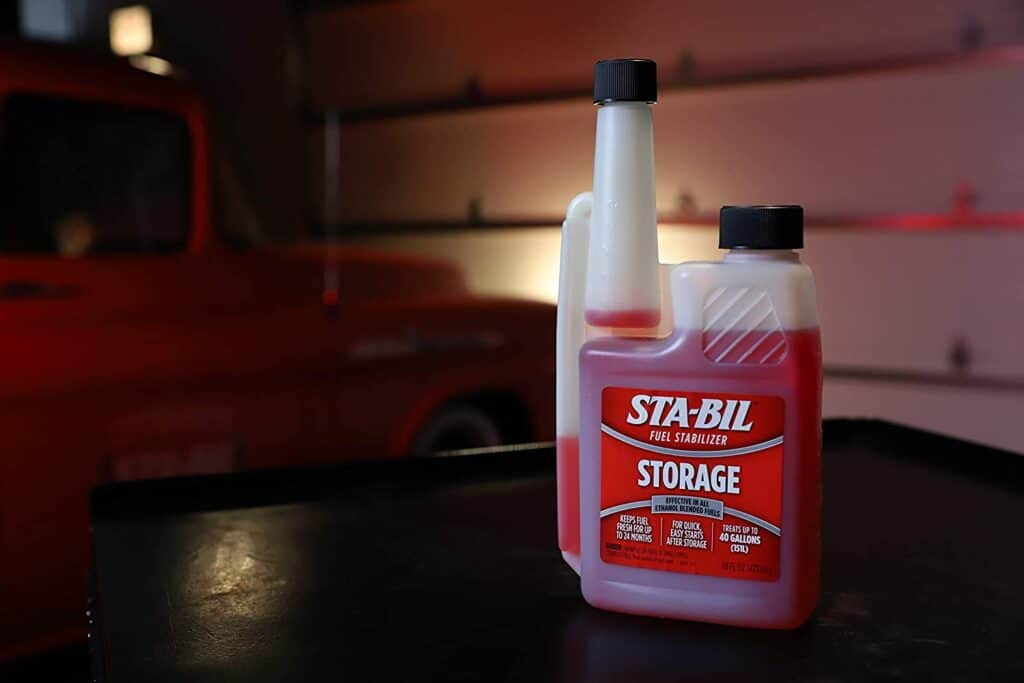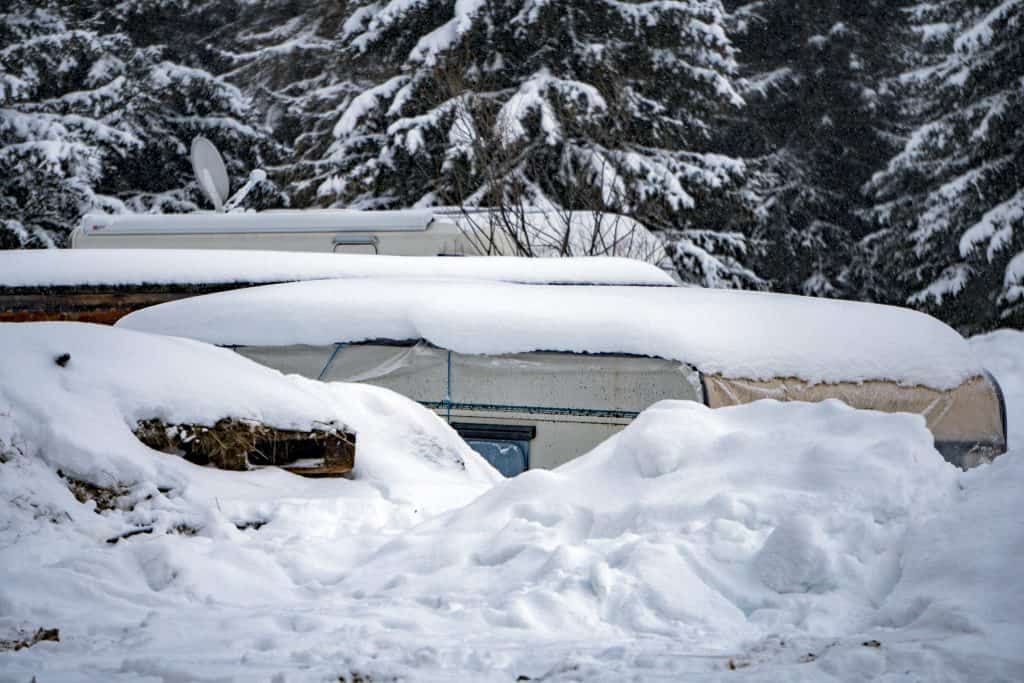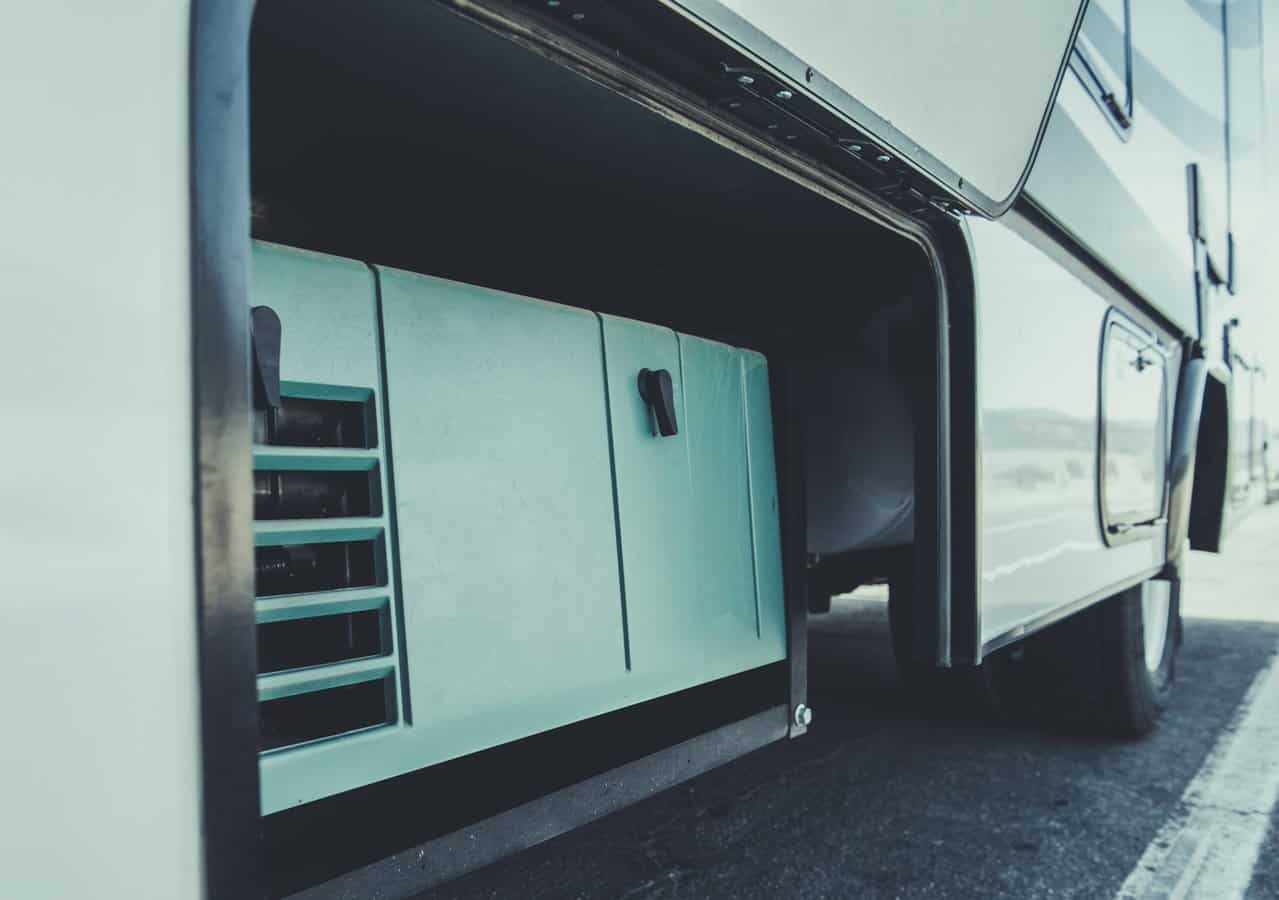If you live in a cold, snowy, climate, it’s critical to properly store an RV in winter. If you don’t, when spring arrives you will pay the price for not winterizing your RV. Don’t worry though, I will walk you through the whole process. Keep reading for tips to help you make your RV last longer, too. After all, who doesn’t want their RV to last many years? I know I do.

Four Steps to Store an RV in Winter the Smart Way!
These four steps can help store an RV in winter without doing damage.
- Drain all water from the plumbing system.
- Fill the plumbing system with RV antifreeze.
- Winterize RV batteries.
- Cover the RV.
These four steps are the most critical to avoid damage. But keep reading for other best practices to winterize your RV when the frost comes.
Drain water from your RV plumbing system
I said it once and I will say it again: Drain your pipes! This is the most important step in winterizing your RV. As you know, water expands when frozen. If you leave water in those pipes, they will crack open. This causes tons of damage, and requires you to spend lots of time and money fixing it. Just drain your pipes to avoid the problem.
To be extra safe, you can even fill your plumbing system with antifreeze. I do this every fall before the first freeze happens. To be clear, this is NOT the same type of antifreeze you put into your car. RV antifreeze is non-toxic and clearly labeled “RV Antifreeze.”
Run antifreeze through the hot water tank bypass
Put antifreeze into the hot water tank bypass before putting RV antifreeze into your entire system. This is a short stretch of tubing that connects to the intake pipe of the hot water heater (cold pipe). It also connects to the output of the hot water heater (the hot pipe). If your RV doesn’t have one, you can easily install this bypass.
Using the hot water tank bypass creates a path for antifreeze to stay out of the hot water tank. This helps cut down on the amount of antifreeze your RV plumbing system requires. With the bypass in place, the hot water heater gets drained separately. Draining procedures vary with each RV. But in general, all it requires is opening that valve to let water out.
Also be sure to drain the waste water lines, valves and tanks. You definitely don’t want that system breaking.
Pour antifreeze into your freshwater intake.
Drain as much of your fresh water tank as possible. If possible, park your RV on a spot slanted in the same direction your water tank plug is facing. Then in goes the RV antifreeze. Use just enough so the water pump can push it into the RV plumbing system.
Next, turn on the water pump to pressurize the system. Run water through your sink, shower, and toilet, one by one. When pink liquid runs from the faucets and toilet, the antifreeze has flushed all the fresh water. Now put antifreeze down every drain.
More important tips to winterize a trailer, motorhome, truck camper, or van
If you follow the steps listed above, you have just winterized your RV plumbing system for winter. But wait, there’s more to do. Here are more important steps for RV winterizing.
Winterize your RV batteries
Have you ever noticed that your smart phone battery drains quickly on a freezing cold day? That’s because cold is not good for batteries. The electrical charge in batteries comes from the controlled reaction of two elements that are floating in a semi-liquid solution. Freezing a battery all winter long is a surefire way to shorten its life. To prevent freezing RV batteries, you have two options:
- Keep your RV plugged in all winter.
- Remove the RV’s batteries and store them inside your house or heated garage. This is the safest option.
If you are store RV batteries inside, keep these things in mind:
- Before putting RV batteries into storage, fully charge them.
- If they are low on water, fill them with distilled water, as always.
- Check the batteries’ charge every two months or so. If they are low on charge, charge them back up.
Once the risk of seasonal freeze dangers has passed, you can connect RV batteries back into place.
Take some weight off of the tires
The less weight that you have on RV tires all winter, the better.
Add fuel stabilizer/biocide
It’s not a good idea to let gas or diesel fuel sit in your motors all winter. It will go bad. If your RV uses unleaded gasoline, add fuel stabilizer to keep the gas from going bad. It also helps your engine start more reliably.

If you have a diesel RV, you need to worry about a different problem. This is the growth of diesel-loving bacteria in the tank. If they are allowed to grow, they produce a slimy film that can ruin your engine. Avoid this problem with fuel microbicide. It kills diesel-loving bacteria and yeast. Add it to your diesel tank before winterizing. Then let the engine idle for a few minutes to run it through the lines.
Cover the RV for winter
You are going to want to cover the trailer if you can’t garage it somewhere. But never cover an RV with a tarp. These cheap plastic tarps are not breathable. RVs with tarp covers will get mold and mildew inside. Yuck! Use a cover designed for your RV type.
RV covers help avoid problems with dirt and UV rays. They also keep wind from ramming objects and debris directly into the RV. Speaking of UV rays, remember that RV exposure to sunlight is damaging, especially to tires and windshield wipers. Sunlight causes rubber to age much faster than normal. Get a cover that protects RV tires or buy RV tire covers too.
Now that you have a proper RV cover, remove food from inside. Before you cover your RV for winter, wash it well and let it dry.
Got a motorized RV? Move it occasionally.
Just like other motorized things that don’t get used during winter (think lawnmower, weed whacker, etc.) it’s a good idea to run your RV engine during winter. Every now and then, get out and remove the RV cover. Turn on the engine and let it warm to full operating temperature. Move it even a couple of feet, just so that the tires don’t get an uneven shape. You don’t need to do this very often, maybe every two months if possible.

Related questions about RV winterization:
Sometimes winterizing RVs for winter isn’t as straight-forward as it seems. Here are some common questions about how to winterize RVs:
It doesn’t freeze where I live. Do I still need to drain the pipes?
I recommend using the fuel biocide and doing a good cleaning and covering no matter where you live during winter. Don’t forget to cover the tires!
Should I use fuel stabilizer?
It is not necessary for motorized RVs. But keep in mind that water condensation can enter your gas tank relatively easily. This causes freeze build-up, which can crack your fuel pipes. Use fuel stabilizer if you live somewhere cold.
Keep track of your RV maintenance
Keep track of all your RV maintenance with an online tool such as RV LIFE Maintenance. This app keeps all your maintenance records and documents in one place, and get email reminders when maintenance is due. This can help you avoid a costly repair or serious accident.
Conclusion
It’s a sad day when it’s time to winterize your RV for the season. But following these tips will help you get back up and running without a hitch come spring. Once you are confident that no more hard freezes will happen, you’re ready to de-winterize the RV for camping season.
To flush the RV antifreeze that sat all winter, fill up your fresh water tank from a hose. The rinse it out a few times. Run water through every tap until it is no longer the color of your RV antifreeze. When water is running clear, remove the hot water tank bypass. Congrats, you’re ready to go RVing!




do you stor a RV with slideouts in or out for winter?